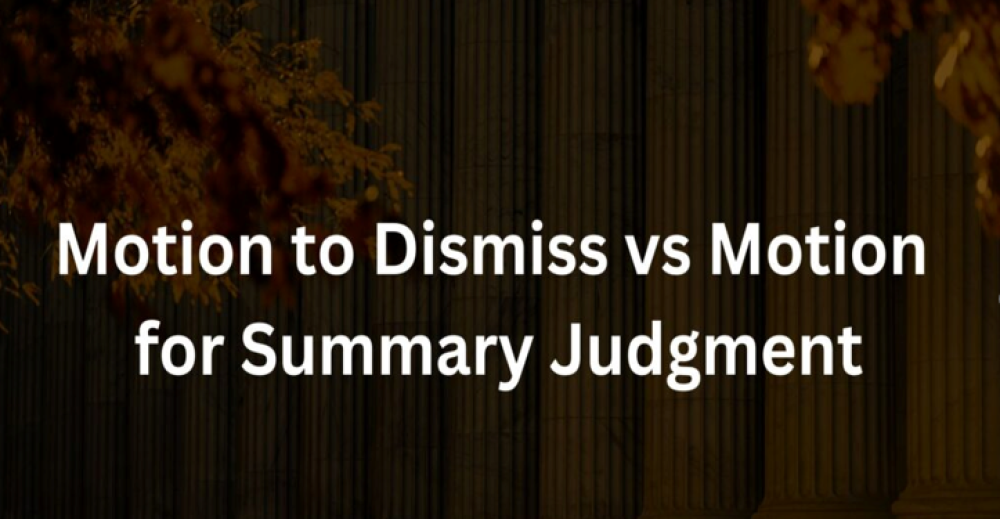
Motions to dismiss and motions for summary judgment are two powerful legal tools used in civil litigation to resolve cases before they reach trial. These motions can save time, reduce litigation costs, and streamline court proceedings. But how do they differ, and when should they be used? Let’s break them down.
What Are Motions to Dismiss and Motions for Summary Judgment?
Motions to dismiss and motions for summary judgment are two powerful legal tools used in civil litigation to resolve cases before they reach trial. These motions can save time, reduce litigation costs, and streamline court proceedings. But how do they differ, and when should they be used? Let’s break them down.
A motion to dismiss is a request made by the defendant asking the court to dismiss a case before any trial proceedings take place. It argues that the plaintiff’s complaint is legally insufficient to proceed.
A motion to dismiss is typically filed at the beginning of a lawsuit, before the defendant answers the complaint. It is based on the legal grounds that even if all facts alleged in the complaint are true, there is no valid legal claim.
A motion to dismiss can be based on various grounds, including:
Lack of jurisdiction – The court does not have the authority to hear the case.
Failure to state a claim – The plaintiff’s complaint does not establish a legal cause of action.
Improper venue – The case has been filed in the wrong court.
Statute of limitations – The plaintiff filed the lawsuit after the legally allowed time limit.
Failure to serve the defendant properly – The plaintiff did not properly notify the defendant about the lawsuit.
If the court grants a motion to dismiss, the case may be dismissed either with prejudice (meaning the plaintiff cannot refile the case) or without prejudice (allowing the plaintiff to correct the issue and refile). If denied, the case proceeds, and the defendant must file an answer.
A motion for summary judgment is a request made by either party, usually after discovery, asking the court to rule in their favor without going to trial. It asserts that there is no genuine dispute of material fact, and the moving party is entitled to judgment as a matter of law.
A motion for summary judgment is typically filed after discovery (the exchange of evidence between parties) but before the trial. It allows a judge to decide the case if the evidence shows no factual disputes requiring a jury’s evaluation.
To succeed on a motion for summary judgment, the moving party must demonstrate that:
No material facts are in dispute – Both parties agree on the facts, leaving only legal issues to resolve.
The law supports a ruling in their favor – The legal principles governing the case clearly indicate that the moving party should win.
If the court grants summary judgment, the case is resolved without going to trial. If denied, the case continues to trial, where a judge or jury will determine the outcome.
Feature Motion to Dismiss Motion for Summary Judgment Timing Filed at the beginning of the case Filed after discovery but before trial Basis Challenges the legal sufficiency of the complaint Challenges the factual basis of the case Evidence Considered Only the complaint and attached documents Evidence from discovery, depositions, affidavits, etc. Possible Outcomes Case is dismissed or allowed to proceed Case is resolved without trial or proceeds to trial
File a Motion to Dismiss if: The complaint itself is legally insufficient, regardless of the facts.
File a Motion for Summary Judgment if: The evidence gathered in discovery proves there are no genuine disputes that require trial.
Yes. A case can see both motions at different stages. A defendant might first file a motion to dismiss, and if it is denied, later file a motion for summary judgment based on the evidence collected.
At Legal Husk, we specialize in drafting legally sound and persuasive motions, ensuring compliance with court rules and procedural requirements. Whether you need a motion to dismiss due to procedural defects or a motion for summary judgment backed by strong evidence, our team ensures precision and professionalism in every document.
Expertise in civil litigation document drafting
Timely and well-researched legal arguments
Custom drafts tailored to specific case needs
Affordable and reliable litigation support
Motions to dismiss and motions for summary judgment are crucial tools in civil litigation. Knowing when and how to use them can significantly impact the outcome of a case. If you need expertly crafted legal documents, Legal Husk is here to assist you.
📩 Contact us today to get started with your legal drafting needs!
Whether you are dealing with a complex family matter, facing criminal charges, or navigating the intricacies of business law, our mission is to provide you with comprehensive, compassionate, and expert legal guidance.